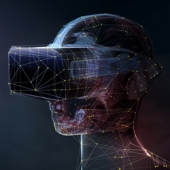IN BRIEF
- 3:17 - If the world is speeding up and your technology isn't, you're going to be left behind. So, the first thing you got to do as a board is understand what you mean by metaverse. So, get somebody, your CIO, your CDO, Chief Digital Officer, an outside person, read and learn what it means.
- 9:07 - The other thing I'll say is Web 3. Web 3 is about better communication. That's lower latency, higher bandwidth and better connectivity. How do I connect to my techs in the field? How do I connect to my construction sites, my factories, my ships, my trucks, my airplanes, and my drones? If I've got better connectivity, I can do all sorts of things—from telemetry, monitoring the performance, to control, to adding more data capabilities to these products.
- 15:25 - What I see out there 10, 15 years out, is our interaction is going to be very different. Very natural. There'll be a lot of language recognition. There'll be gesture recognition. We won't be wearing these headsets because a little thing we wear stuck in our ear and the frames of our glasses will pick up sound perfectly, will do bone conduction. So, the user interface is going to become much more natural.
Are the board and the C-suite ready for the metaverse? Probably not, says renowned tech strategist Wayne Sadin, who has had a 30-year IT career as a CTO, CDO, CIO and advisor to CEOs and boards. So now what? Sadin, currently the lead analyst covering C-suites and board, IT governance, cyber and metaverse for Acceleration Economy, a technology advisory firm, sits down with Joe Kornik, Editor-in-Chief of VISION by Protiviti, to discuss what steps executives should be taking right now to ensure tech success in the future.
Tech expert Wayne Sadin on how the C-suite and board can prepare for the metaverse – Audio transcript
Joe Kornik: Welcome to the VISION by Protiviti interview where we look at how big topics will impact global business over the next decade and beyond. Today, we're talking about the metaverse future. I'm Joe Kornik, Editor-in-Chief of VISION by Protiviti and I'm joined by renowned tech strategist Wayne Sadin. Who has had a 30-year IT career where he's been a CTO, CDO, CIO and advisor to CEOs and boards. Currently, he's the lead analyst covering C-suites and boards, IT governance, cyber and metaverse for Acceleration Economy. Wayne, thanks so much for joining me today on the program.
Wayne Sadin: Hey, Joe. It's a pleasure to be here. Thank you for having me.
Kornik: Wayne, you focused on board strategy at Acceleration Economy, and I think there's some skepticism actually out there. Certainly, some uncertainty about Web 3 and the metaverse among that group, right, the board and the C-suite. Maybe there's some hesitation about perhaps being one of the first in the pool, especially if the water is a little too cold. What advice would you give them as they think about their metaverse future?
Sadin: Well, I think the first thing, Joe, is the board at that level needs to understand what do we mean when we say metaverse? That definition is so hazy and so all encompassing. Let's maybe start with that. So, when people think of the metaverse what they think of is the virtual reality headset. So, here is a state-of-the-art VR headset right now. I mean, this new one just got announced. This is what I wear when I want to play. Can you imagine your board director wearing this five-pound thing on their head for a board meeting? I can't. So, first of all, it's VR, it’s AR, augmented reality or XR, extended reality. So, all of these things that involve taking visual and audio and maybe one day, touch, your tactile sensation, and making them available to people at a distance. So, that's one view of it. Another one is cryptocurrency, which is a whole another discussion. Then the third part of it is the Web 3, the underlying technology of the metaverse. Now can you do metaverse without Web3? Yes. Can you do Web 3 without metaverse? Yes. What happens when you put them together is you get something bigger than either.
So, if you're a board, you want to be educating yourself on what is your business strategy relate to in AR and VR, XR all those R things? Are you a game company? Are you a consumer products company where the gamification of your interaction really matters, or do you make industrial widgets and maybe you need something to help train your people or guide the technicians when they're doing the repair. Or maybe you're just a company that wants to get more nimble and be able to react as the economy goes ever, ever faster and faster? Acceleration Economy, where I do a lot of work, is about the rate of change of the world. If the world is speeding up and your technology isn't, you're going to be left behind. So, the first thing you got to do as a board is understand what you mean by metaverse. So, get somebody, your CIO, your CDO, Chief Digital Officer, an outside person, read and learn what it means.
Kornik: Right. They're in a tough position certainly. I know you talk to them frequently and a lot about readiness and where they are in this process. In your opinion, are they ready? If not, what steps should the board be taking to get themselves ready?
Sadin: Boards are generally not ready for the metaverse. Now there are exceptions. Again, there were these digitally enabled companies. There's a whole lot of startups. But I tend to work with what I would call flyover companies or companies making things, whether it's financial services, or shipping, or manufacturing, or healthcare. They're not in the technology business per se, they just use technology. In most cases, companies are woefully behind in technology. The quick example from a couple of weeks ago was Southwest Airlines—technical debt sunk them. They were however many releases behind on a major piece of software, and that crippled them during a time of great stress.
So, my first message to boards—and Joe, it's a message I give boards no matter what we're talking about—is technical debt is an unfunded, generally unknown, off-balance-sheet liability. In many companies, it's bigger than what sunk Enron and WorldCom 25 years ago. If you are a board member, or a CEO, CFO, and you don't know what your company's technical debt is—I'll define it in the minute—you really are in for a world of disappointment. If you've got to respond to a competitive initiative, if you've got to do something around your M&A strategy, growth strategy, whatever it may be.
So, quickly the definition is, technical debt is the sum total of all the technology changes since you put the stuff in that you didn't apply. It's the 15-year-old server, running a piece of software that's 12 releases behind. It's the old mainframe system that is at the end of its life and nobody knows how to program it anymore because they all retired or died. It's the collection of things you bought because you've done 42 M&A acquisitions, and now you have 23 data centers, and you haven't rationalized it. All of those things are millstones around your neck, preventing you from moving into the future. Metaverse is the top-level thing that needs a lot of modern components but just about everything else you want to do, IT gets to say, “Hmmm, I need a couple of years to do that,” or they rush it through and quite frankly, screw it up. So, if you're a board, you should be focused, if you're looking at the metaverse, Web3, on where are we today, versus where we need to be to compete.
Kornik: How should executives be thinking about ROI? I mean, it strikes me that investments in the metaverse may be a long way away about seeing any return on that investment. Will they need to shift their typical timetable or their traditional thinking or metric around ROI for the metaverse?
Sadin: Well, no, I don't think so. Again, if you're a company that needs to be on the cutting edge of some game technology or something like that, you have an R&D budget, and that doesn't have an ROI typically. R&D is what you invest in the hope that you'll get something back out of it, just like the venture capital investments. So, if you're making speculative investments, keep making them. For most of us, if I'm investing in technology—let's talk about a particular thing, augmented reality. So, I'm in a business where I make something and have to fix it. What can I be doing to make my techs better at fixing things? How can I give them the power of visual representation? I've got a camera pointing at something. I've got an AI system behind it, or you know what? Maybe I have a 50-year experienced tech who doesn't want to go out in the field, looking at that camera. Then I take my junior tech and I whisper in their ear with a headset. Go look here first. Go look there second. I once was involved with a system, Joe, where we were inspecting an oil rig kind of thing. Very dirty, very dangerous for people, you have to have a lot of training to go do it. Instead of having to fly senior techs in helicopters, just didn't want to get the helicopter. Have you ever taken the training where you go to an offshore platform in helicopter where they’d throw you in the water upside down? You'll know why you don't want to do that. We could take a junior tech and give them, it was an iPad with a camera, and they could point it at the oil rig pieces and it would tell them what to inspect first, because it was a digital twin although they didn't call it that in those days. It was a digital twin of the platform. So, we made the techs smarter by giving them the ability to visualize the physical environment around them. Then when they got to the component that it said inspect, you could scrape the oil off and read the barcode and it would give you a schematic, “Inspect it this way.” So, there's an investment that creates a tremendous ROI. It also builds a capability because now you can do that, what do you do in your manufacturing lines? What do you do to enable your customers maybe to do that?
So, I want to say, Joe, for a lot of these investments in metaverse—if it's augmented reality, if it's taking data, visual, and audio and superimposing them—there is a tremendous payoff if you have the right infrastructure.
The other thing I'll say is Web 3. Web 3 is about better communication. That's lower latency, higher bandwidth and better connectivity. How do I connect to my techs in the field? How do I connect to my construction sites, my factories, my ships, my trucks, my airplanes, and my drones? If I've got better connectivity, I can do all sorts of things—from telemetry, monitoring the performance, to control, to adding more data capabilities to these products. So, if I'm in making thoughtful investments, let me describe it this way. I call it a brick-in-the-wall strategy. If I want to build the Taj Mahal, I could draw the blueprint and say, 14 years from now, I’m going to have it built. I'd rather draw the blueprint, and then ask my business units to pay for the bricks. So, this brick has to be built before this brick before this brick before this brick, but I may not want to buy any bricks over there, because I don't need them yet. So, I'll say to the board, what is the architecture? What is the business architecture? What is the technical architecture that you're shooting for? And now, how do you invest brick by brick with ROI for the most part, or R&D spending on the other part, to get you where you want to be in a timely manner with manageable risk and decent-to-great ROI?
Kornik: Wayne, let's talk a little bit about those technologies that you mentioned earlier that will enable all of this, whether it's that headset that you showed us a few minutes ago or even generative AI which is getting a lot of press these days. Where do you think we are in sort of the maturity of these technologies, which ones are you most excited about, and when do you think they all come together to deliver what a lot of us think the metaverse could be?
Sadin: Well, until about two months ago, I wouldn't have told you AI was as close to being useful every day as it appears to be now. These multibillion-dollar investments made by the arms merchants, Microsoft and Google and I'm sure others are really changing the landscape on AI now. There's a lot of risk to this. We had the great excitement about generative AI and look all the things that it can do and then we discovered that ChatGPT can't do math. 200 plus 200 is 500. No, it makes mistakes on facts. It was trained weirdly. So, if you are a board or C-suite, and you're using AI, you've got to look at the risk of bias, or have you not fed it direct dataset. Have you fed it a slanted dataset? Have you not included your own information? Or maybe—here's another risk that I thought about—what if your information is leaking out inadvertently, inadvertent disclosure and winding up in some AI model that's letting other people know more about you than you want them to know? So, AI is clearly moving very, very fast. Dare I say maybe a little too fast? Because we don't want to be seduced by the hype.
Back to the solid technologies, it's communications connectivity. It’s Starlink, it’s 5G. It's building software-defined networks. Again, I hate to talk technical to boards and C-suites. Ask your IT department, “ Do we have a software-defined network?” which just means that I can pivot the network very, very quickly. In the old days we bought a thing, we put it into the forklift. When we needed a better thing, we got another forklift. With a software-defined network, if we do an acquisition in another country, we can build the rules into the network very quickly and go live very quickly, whether it's by satellite, 5G, or a hotspot in your hand. So, invest in your communications technology. Again, technical thing. Bandwidth is great, how fast I can push data down the pipe, but latency, how long it takes the message to go back and forth is even more important in the metaverse. If you and I are talking and our latency is very quick, you see my hands move, you seen my mouth move, you see the sensor reading. If latency is long, there's that lag and your drone flies into the wall. Your blade cuts the wrong angle, and your car drives into the pole. So, we got to be fixing latency. Again, a little bit geeky, but it's important to be building the right networks because everything sits on the network.
Then the other one is going to be cloud. Look, I don't want to say cloud’s the answer to all problems. The investments being made by the cloud companies, Joe, and the $50 billion a year and more range means for most of us, we can piggyback on what they're spending and buy a tiny little slice of AI or augmented reality or Internet of Things instead of having to build our own infrastructure ourselves. So, it gives you a tremendous amount of optionality and helps you remove a tremendous amount of technical debt. Because if Microsoft spends $10 billion on AI, which they just announced, guess what? We all get to use it for $1.98 a month per user or whatever the price is going to be. You can't do that if you have to build it yourself.
Then the technology, this thing I showed you here. Until we get away from this kind of stuff, and we start thinking about a projector on your desk that's holographic, or I envision something that maybe you’ll take your eyeglasses and put a thing on your chest with a battery pack that's not sitting on your head and then shine a light up into your glasses and use an interference pattern or do a face mask if you're in an industrial environment. When we can change the physical experience, I think that stuff will take off dramatically. Again, that's not where I'd be making my investment other than in the ability to use whatever technology comes out later.
Kornik: Sure. That teed me up for my last question, Wayne, which is, I'd like you as a visionary, a futurist, and a tech expert to take me out a decade or more. Take me out to 2035 or even 2040 and dream a bit and tell me what's the metaverse’s role and how will it impact our daily lives, our working lives. What do you see when you look out to 2035, 2040?
Sadin: What I see out there 10, 15 years out, is our interaction is going to be very different. Very natural. There'll be a lot of language recognition. There'll be gesture recognition. We won't be wearing these headsets because a little thing we wear stuck in our ear and the frames of our glasses will pick up sound perfectly, will do bone conduction. So, the user interface is going to become much more natural. We won't be getting carpal tunnel syndrome by typing all day. We'll be gesturing, talking, and moving, all the stuff you see in Minority Report is not that far away. The things that move when you move your hands and all that, it's there in some applications already. The communication networks. Again, I keep coming back to that, it's fundamental. If I can't connect, wherever I am, wherever I am, with low latency and high bandwidth, a lot of what I want to do doesn't work well. If I've got five million cars on the road, they have to be able to talk to each other. They have to be able to talk back to the infrastructure. So, we've got to be enabling individually, we've got to be enabling as companies, we got to be enabling quite frankly, as nation states good, effective communication, so that all this stuff can happen. I think it's going to be a life where we have intelligent agents that do a lot more, the Siris and the other products that make your life easier in many cases, and it's going to change the world. One thing we do know is we never know how it's going to change the world but it's going to make us probably faster, smarter, stronger, and more productive, even maybe at the expense of some other things.
Kornik: Thanks for your time today, Wayne. I really enjoyed this.
Sadin: It was a pleasure. Happy to have the conversation. I look forward to follow-ups. If people have questions, engage with me on LinkedIn and Twitter, please.
Kornik: Sounds great. Thank you so much. Thank you for watching the VISION by Protiviti interview for Wayne Sadin, I'm Joe Kornik. We'll see you next time.
Did you enjoy this content? For more like this, subscribe to the VISION by Protiviti newsletter.


































